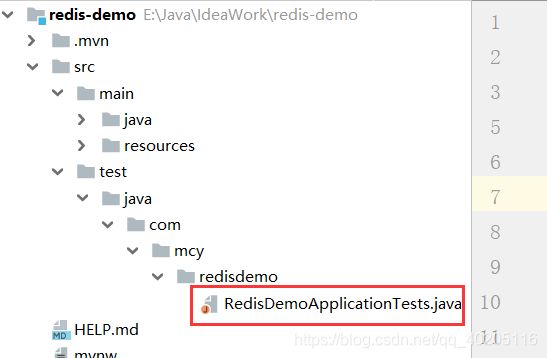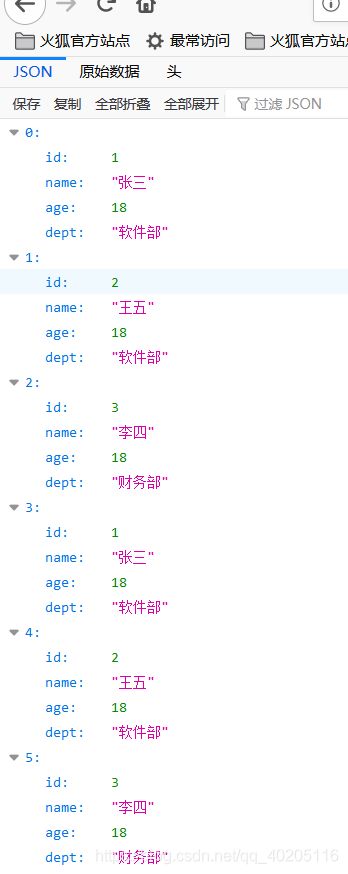SpringBoot整合Redis(项目实战篇)
写在前面: 从2018年底开始学习SpringBoot,也用SpringBoot写过一些项目。现在想对学习Springboot的一些知识总结记录一下。如果你也在学习SpringBoot,可以关注我,一起学习,一起进步。如果对Redis的数据类型不了解的小伙伴,可以先了解一下:Redis数据类型及基本使用。
相关文章:
【Springboot系列】Springboot入门到项目实战
文章目录
- Redis
- 1、Redis简介
- 2、Redis特点
- 搭建项目
- 1、项目结构
- 2、新建Springboot项目
- 3、配置链接信息
- 测试链接
- 1、测试
- 2、查看效果
- Springboot整合Redis使用
- 1、Redis配置类
- 2、RedisTemplate封装
- 3、编写实体类
- 4、RedisController类
- 5、测试
- 6、案例代码下载
Redis
1、Redis简介
Redis 是一个开源(BSD许可)的,内存中的数据结构存储系统,它可以用作数据库、缓存和消息中间件。 它支持多种类型的数据结构,如 字符串(strings), 散列(hashes), 列表(lists), 集合(sets), 有序集合(sorted sets) 与范围查询, bitmaps, hyperloglogs 和 地理空间(geospatial) 索引半径查询。 Redis 内置了 复制(replication),LUA脚本(Lua scripting), LRU驱动事件(LRU eviction),事务(transactions) 和不同级别的 磁盘持久化(persistence), 并通过 Redis哨兵(Sentinel)和自动 分区(Cluster)提供高可用性(high availability)。
2、Redis特点
- 性能极高 – Redis能读的速度是110000次/s,写的速度是81000次/s 。
- 支持多种数据结构:string(字符串);list(列表);hash(哈希),set(集合);zset(有序集合)
- 原子 – Redis的所有操作都是原子性的,意思就是要么成功执行要么失败完全不执行。单个操作是原子性的。多个操作也支持事务,即原子性,通过MULTI和EXEC指令包起来。
- 丰富的特性 – Redis还支持 publish/subscribe, 通知, key 过期等等特性。
搭建项目
1、项目结构
2、新建Springboot项目
新建项目需要添加web和redis的依赖,完整的pom.xml依赖代码如下:
4.0.0
org.springframework.boot
spring-boot-starter-parent
2.2.2.RELEASE
com.mcy
redis-demo
0.0.1-SNAPSHOT
redis-demo
Demo project for Spring Boot
1.8
org.springframework.boot
spring-boot-starter-data-redis
org.springframework.boot
spring-boot-starter-web
org.springframework.boot
spring-boot-starter-test
test
org.junit.vintage
junit-vintage-engine
org.springframework.boot
spring-boot-maven-plugin
3、配置链接信息
server.port=80
server.servlet.context-path=/
#reids相关配置
#redis服务器地址
spring.redis.host=localhost
#雷迪森服务器端口
spring.redis.port=6379
#redis密码,默认为空
spring.redis.password=
#redis数据库索引(默认为0)
spring.redis.database=0
#连接池对打阻塞等待时间(负表示没有限制)
spring.redis.jedis.pool.max-wait=10000
#连接池最大连接数(负表示没有限制)
spring.redis.jedis.pool.max-active=100
#连接池中的最大空闲链接
spring.redis.jedis.pool.max-idle=20
#连接池中的最小空闲链接
spring.redis.jedis.pool.min-idle=0
#链接超时时间
spring.redis.timeout=3000
测试链接
1、测试
在RedisDemoApplicationTests测试类中,编写代码测试连接。

测试代码如下:
import org.junit.jupiter.api.Test;
import org.springframework.beans.factory.annotation.Autowired;
import org.springframework.boot.test.context.SpringBootTest;
import org.springframework.data.redis.core.RedisTemplate;
@SpringBootTest
class RedisDemoApplicationTests {
@Autowired
private RedisTemplate redisTemplate;
@Test
void contextLoads() {
//向redis中添加数据
redisTemplate.opsForValue().set("keys", "value值");
//根据键值取出数据
System.out.println(redisTemplate.opsForValue().get("keys"));
}
}
【释】 RedisTemplate是Spring Data Redis提供给用户的最高级的抽象客户端,用户可直接通过RedisTemplate对redis进行操作。操作方法即redis的指令,关于redis的指令的操作可以移步:Redis数据类型及基本使用。
可以点进去看一下RedisTemplate继承关系和方法,下面是继承关系,方法就比较多了,这里就不贴出来了,感兴趣的小伙伴可以直接去RedisTemplate类中看看。
//RedisAccessor是RedisTemplate定义普通属性的基类,不直接使用
//RedisOperations是指定RedisTemplate实现的Redis connection操作的集合接口
//BeanClassLoaderAware是给其实现类是设置类加载器的接口
RedisTemplate extends RedisAccessor implements RedisOperations, BeanClassLoaderAware
【注】 上述的测试案例中RedisTemplate中的value值设置的是String类型,但redis有五种数据类型,所以这里最好使用Object类型。
@Resource
private RedisTemplate redisTemplate;
这里注解如果继续使用@AutoWired会报错,需要使用@Resource,这两个注解的区别在前者是根据类型后者是根据名字(报错原因:@AutoWired找不到该类型
操作不同类型的数据,调用的方法不同
- 操作String字符串类型数据时,使用RedisTemplate类中的opsForValue方法操作。
- 操作List列表类型数据时,使用RedisTemplate类中的opsForList方法操作。
- 操作Set集合类型数据时,使用RedisTemplate类中的opsForSet方法操作。
- 操作Hash哈希类型数据时,使用RedisTemplate类中的opsForHash方法操作。
- 操作Zset有序集合类型数据时,使用RedisTemplate类中的opsForZSet方法操作。
2、查看效果
查看Redis中的数据,可以使用RedisDesktopManager工具查看。

Springboot整合Redis使用
上述操作可以直接在Springboot项目中使用。但也可以对redisTemplate的操作进行一下简单的封装。
1、Redis配置类
Redis配置类RedisConfig类代码如下:
import com.fasterxml.jackson.annotation.JsonAutoDetect;
import com.fasterxml.jackson.annotation.PropertyAccessor;
import com.fasterxml.jackson.databind.ObjectMapper;
import org.springframework.cache.annotation.CachingConfigurerSupport;
import org.springframework.cache.annotation.EnableCaching;
import org.springframework.context.annotation.Bean;
import org.springframework.context.annotation.Configuration;
import org.springframework.data.redis.connection.RedisConnectionFactory;
import org.springframework.data.redis.core.*;
import org.springframework.data.redis.serializer.Jackson2JsonRedisSerializer;
import org.springframework.data.redis.serializer.StringRedisSerializer;
/**
* redis配置类
*/
@Configuration
@EnableCaching
public class RedisConfig extends CachingConfigurerSupport {
/**
* retemplate相关配置
* @param factory
* @return
*/
@Bean
public RedisTemplate redisTemplate(RedisConnectionFactory factory) {
RedisTemplate template = new RedisTemplate<>();
// 配置连接工厂
template.setConnectionFactory(factory);
//使用Jackson2JsonRedisSerializer来序列化和反序列化redis的value值(默认使用JDK的序列化方式)
Jackson2JsonRedisSerializer jacksonSeial = new Jackson2JsonRedisSerializer(Object.class);
ObjectMapper om = new ObjectMapper();
// 指定要序列化的域,field,get和set,以及修饰符范围,ANY是都有包括private和public
om.setVisibility(PropertyAccessor.ALL, JsonAutoDetect.Visibility.ANY);
// 指定序列化输入的类型,类必须是非final修饰的,final修饰的类,比如String,Integer等会跑出异常
om.enableDefaultTyping(ObjectMapper.DefaultTyping.NON_FINAL);
jacksonSeial.setObjectMapper(om);
// 值采用json序列化
template.setValueSerializer(jacksonSeial);
//使用StringRedisSerializer来序列化和反序列化redis的key值
template.setKeySerializer(new StringRedisSerializer());
// 设置hash key 和value序列化模式
template.setHashKeySerializer(new StringRedisSerializer());
template.setHashValueSerializer(jacksonSeial);
template.afterPropertiesSet();
return template;
}
/**
* 对hash类型的数据操作
*
* @param redisTemplate
* @return
*/
@Bean
public HashOperations hashOperations(RedisTemplate redisTemplate) {
return redisTemplate.opsForHash();
}
/**
* 对redis字符串类型数据操作
*
* @param redisTemplate
* @return
*/
@Bean
public ValueOperations valueOperations(RedisTemplate redisTemplate) {
return redisTemplate.opsForValue();
}
/**
* 对链表类型的数据操作
*
* @param redisTemplate
* @return
*/
@Bean
public ListOperations listOperations(RedisTemplate redisTemplate) {
return redisTemplate.opsForList();
}
/**
* 对无序集合类型的数据操作
*
* @param redisTemplate
* @return
*/
@Bean
public SetOperations setOperations(RedisTemplate redisTemplate) {
return redisTemplate.opsForSet();
}
/**
* 对有序集合类型的数据操作
*
* @param redisTemplate
* @return
*/
@Bean
public ZSetOperations zSetOperations(RedisTemplate redisTemplate) {
return redisTemplate.opsForZSet();
}
}
2、RedisTemplate封装
RedisTemplate封装工具类代码如下:
import org.springframework.beans.factory.annotation.Autowired;
import org.springframework.data.redis.core.RedisTemplate;
import org.springframework.stereotype.Component;
import org.springframework.util.CollectionUtils;
import java.util.List;
import java.util.Map;
import java.util.Set;
import java.util.concurrent.TimeUnit;
/**
* redisTemplate封装
*
*/
@Component
public class RedisUtil {
@Autowired
private RedisTemplate redisTemplate;
public RedisUtil(RedisTemplate redisTemplate) {
this.redisTemplate = redisTemplate;
}
/**
* 指定缓存失效时间
* @param key 键
* @param time 时间(秒)
* @return
*/
public boolean expire(String key,long time){
try {
if(time>0){
redisTemplate.expire(key, time, TimeUnit.SECONDS);
}
return true;
} catch (Exception e) {
e.printStackTrace();
return false;
}
}
/**
* 根据key 获取过期时间
* @param key 键 不能为null
* @return 时间(秒) 返回0代表为永久有效
*/
public long getExpire(String key){
return redisTemplate.getExpire(key,TimeUnit.SECONDS);
}
/**
* 判断key是否存在
* @param key 键
* @return true 存在 false不存在
*/
public boolean hasKey(String key){
try {
return redisTemplate.hasKey(key);
} catch (Exception e) {
e.printStackTrace();
return false;
}
}
/**
* 删除缓存
* @param key 可以传一个值 或多个
*/
@SuppressWarnings("unchecked")
public void del(String ... key){
if(key!=null&&key.length>0){
if(key.length==1){
redisTemplate.delete(key[0]);
}else{
redisTemplate.delete(CollectionUtils.arrayToList(key));
}
}
}
//============================String=============================
/**
* 普通缓存获取
* @param key 键
* @return 值
*/
public Object get(String key){
return key==null?null:redisTemplate.opsForValue().get(key);
}
/**
* 普通缓存放入
* @param key 键
* @param value 值
* @return true成功 false失败
*/
public boolean set(String key,Object value) {
try {
redisTemplate.opsForValue().set(key, value);
return true;
} catch (Exception e) {
e.printStackTrace();
return false;
}
}
/**
* 普通缓存放入并设置时间
* @param key 键
* @param value 值
* @param time 时间(秒) time要大于0 如果time小于等于0 将设置无限期
* @return true成功 false 失败
*/
public boolean set(String key,Object value,long time){
try {
if(time>0){
redisTemplate.opsForValue().set(key, value, time, TimeUnit.SECONDS);
}else{
set(key, value);
}
return true;
} catch (Exception e) {
e.printStackTrace();
return false;
}
}
/**
* 递增
* @param key 键
* @param delta 要增加几(大于0)
* @return
*/
public long incr(String key, long delta){
if(delta<0){
throw new RuntimeException("递增因子必须大于0");
}
return redisTemplate.opsForValue().increment(key, delta);
}
/**
* 递减
* @param key 键
* @param delta 要减少几(小于0)
* @return
*/
public long decr(String key, long delta){
if(delta<0){
throw new RuntimeException("递减因子必须大于0");
}
return redisTemplate.opsForValue().increment(key, -delta);
}
//================================Map=================================
/**
* HashGet
* @param key 键 不能为null
* @param item 项 不能为null
* @return 值
*/
public Object hget(String key,String item){
return redisTemplate.opsForHash().get(key, item);
}
/**
* 获取hashKey对应的所有键值
* @param key 键
* @return 对应的多个键值
*/
public Map hmget(String key){
return redisTemplate.opsForHash().entries(key);
}
/**
* HashSet
* @param key 键
* @param map 对应多个键值
* @return true 成功 false 失败
*/
public boolean hmset(String key, Map map){
try {
redisTemplate.opsForHash().putAll(key, map);
return true;
} catch (Exception e) {
e.printStackTrace();
return false;
}
}
/**
* HashSet 并设置时间
* @param key 键
* @param map 对应多个键值
* @param time 时间(秒)
* @return true成功 false失败
*/
public boolean hmset(String key, Map map, long time){
try {
redisTemplate.opsForHash().putAll(key, map);
if(time>0){
expire(key, time);
}
return true;
} catch (Exception e) {
e.printStackTrace();
return false;
}
}
/**
* 向一张hash表中放入数据,如果不存在将创建
* @param key 键
* @param item 项
* @param value 值
* @return true 成功 false失败
*/
public boolean hset(String key,String item,Object value) {
try {
redisTemplate.opsForHash().put(key, item, value);
return true;
} catch (Exception e) {
e.printStackTrace();
return false;
}
}
/**
* 向一张hash表中放入数据,如果不存在将创建
* @param key 键
* @param item 项
* @param value 值
* @param time 时间(秒) 注意:如果已存在的hash表有时间,这里将会替换原有的时间
* @return true 成功 false失败
*/
public boolean hset(String key,String item,Object value,long time) {
try {
redisTemplate.opsForHash().put(key, item, value);
if(time>0){
expire(key, time);
}
return true;
} catch (Exception e) {
e.printStackTrace();
return false;
}
}
/**
* 删除hash表中的值
* @param key 键 不能为null
* @param item 项 可以使多个 不能为null
*/
public void hdel(String key, Object... item){
redisTemplate.opsForHash().delete(key,item);
}
/**
* 判断hash表中是否有该项的值
* @param key 键 不能为null
* @param item 项 不能为null
* @return true 存在 false不存在
*/
public boolean hHasKey(String key, String item){
return redisTemplate.opsForHash().hasKey(key, item);
}
/**
* hash递增 如果不存在,就会创建一个 并把新增后的值返回
* @param key 键
* @param item 项
* @param by 要增加几(大于0)
* @return
*/
public double hincr(String key, String item,double by){
return redisTemplate.opsForHash().increment(key, item, by);
}
/**
* hash递减
* @param key 键
* @param item 项
* @param by 要减少记(小于0)
* @return
*/
public double hdecr(String key, String item,double by){
return redisTemplate.opsForHash().increment(key, item,-by);
}
//============================set=============================
/**
* 根据key获取Set中的所有值
* @param key 键
* @return
*/
public Set 3、编写实体类
新建Stu.java实体类,代码如下:
public class Stu {
private Integer id;
private String name; //姓名
private Integer age; //年龄
private String dept; //部门
public Integer getId() {
return id;
}
public void setId(Integer id) {
this.id = id;
}
public String getName() {
return name;
}
public void setName(String name) {
this.name = name;
}
public Integer getAge() {
return age;
}
public void setAge(Integer age) {
this.age = age;
}
public String getDept() {
return dept;
}
public void setDept(String dept) {
this.dept = dept;
}
}
4、RedisController类
RedisController类,其中写了几个测试方法,可以自行添加其他方法。操作Redis时可以用原生的RedisTemplate方法,也可以用封装的RedisUtil类中的方法。代码如下:
import com.mcy.redisdemo.entity.Stu;
import com.mcy.redisdemo.util.RedisUtil;
import org.springframework.beans.factory.annotation.Autowired;
import org.springframework.data.redis.core.RedisTemplate;
import org.springframework.web.bind.annotation.RequestMapping;
import org.springframework.web.bind.annotation.RestController;
import javax.annotation.Resource;
import java.util.ArrayList;
import java.util.List;
@RestController
@RequestMapping(value = "/redis")
public class RedisController {
@Resource
private RedisTemplate redisTemplate;
@Autowired
private RedisUtil redisUtil;
/**
* 获取对应键的值,redisTemplate操作
* @param key
* @return
*/
@RequestMapping(value = "get")
public Object getValue(String key){
Object value = redisTemplate.opsForValue().get(key);
return value;
}
/**
* 添加键值
* @param key
* @param value
* @return
*/
@RequestMapping(value = "set")
public boolean set(String key, String value){
return redisUtil.set(key, value);
}
/**
* 添加List对象数据到redis中
* @return
*/
@RequestMapping(value = "/setList")
public boolean setList(){
List stuList = new ArrayList<>();
Stu stu = new Stu();
stu.setId(1);
stu.setAge(18);
stu.setDept("软件部");
stu.setName("张三");
Stu stu1 = new Stu();
stu1.setId(2);
stu1.setAge(18);
stu1.setDept("软件部");
stu1.setName("王五");
Stu stu2 = new Stu();
stu2.setId(3);
stu2.setAge(18);
stu2.setDept("财务部");
stu2.setName("李四");
stuList.add(stu);
stuList.add(stu1);
stuList.add(stu2);
return redisUtil.lSetList("stu", stuList);
}
/**
* 获取全部数据
* @return
*/
@RequestMapping(value = "getList")
public Object getList(){
return redisUtil.lGet("stu", 0, -1);
}
}
5、测试
运行项目后访问setList方法,添加数据到Redis缓存中。添加后可以用RedisDesktopManager工具查看添加后的数据。

访问getList方法,查询对应键值的list数据。

这里就只测试了这两个方法,对于Redis的操作使用String类型来存储的比较多,上面写的有字符串的保存于读取方法,大家可以自行测试。这里主要就对于List类型,List中存放的对象进行了一下测试。
这里注意一下:一般Redis只用做缓存,Redis中的数据一般数据库中的都有,查询时先查询Redis中是否存在,不存在则查询数据库中数据。
6、案例代码下载
案例代码GitHub下载地址:https://github.com/machaoyin/Redis-Demo
最后有什么不足之处,欢迎大家指出,期待与你的交流。
